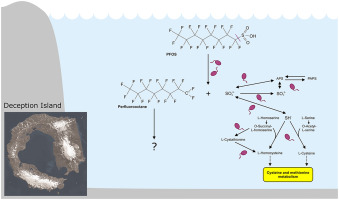当前位置:
X-MOL 学术
›
Water Res.
›
论文详情
Our official English website, www.x-mol.net, welcomes your
feedback! (Note: you will need to create a separate account there.)
Microbial responses to perfluoroalkyl substances and perfluorooctanesulfonate (PFOS) desulfurization in the Antarctic marine environment.
Water Research ( IF 11.4 ) Pub Date : 2019-12-24 , DOI: 10.1016/j.watres.2019.115434 Elena Cerro-Gálvez 1 , Jose L Roscales 2 , Begoña Jiménez 2 , M Montserrat Sala 3 , Jordi Dachs 1 , Maria Vila-Costa 1
Water Research ( IF 11.4 ) Pub Date : 2019-12-24 , DOI: 10.1016/j.watres.2019.115434 Elena Cerro-Gálvez 1 , Jose L Roscales 2 , Begoña Jiménez 2 , M Montserrat Sala 3 , Jordi Dachs 1 , Maria Vila-Costa 1
Affiliation

|
Perfluorooctanesulfonate (PFOS) and perfluorooctanoate (PFOA) acids are ubiquitous in the oceans, including remote regions, and are toxic to fish and mammals. The impact to the lowest trophic levels of the food web, however, remains unknown. We challenged natural bacterial communities inhabiting Antarctic coastal waters (Deception Island) with PFOS and PFOA concentrations ranging from 2 ng/L to 600 ng/L that selected for tolerant taxa. After 48 h, concentrations of PFOS decreased by more than 50% and sulfur metabolism-related transcripts were significantly enriched in the treatments suggesting desulfurization of PFOS. Conversely, no significant differences were found between initial and final PFOA concentrations. Gammaproteobacteria and Roseobacter, two abundant groups of marine bacteria, increased their relative activity after 24 h of incubation, whereas Flavobacteriia became the main contributor in the treatments after 6 days. Community activities (extracellular enzyme activity and absolute number of transcripts) were higher in the treatments than in the controls, while bacterial abundances were lower in the treatments, suggesting a selection of PFOS and PFOA tolerant community in the exposed treatments. Our results show a direct effect of PFOS and PFOA exposure on the composition and functionality of natural Antarctic marine microbial communities. While no evidence of defluorination of PFOS or PFOA was detected, probable desulfurization of PFOS depicts a direct link with the sulfur biogeochemistry of the ocean.
中文翻译:

南极海洋环境中微生物对全氟烷基物质和全氟辛烷磺酸盐(PFOS)脱硫的响应。
全氟辛烷磺酸(PFOS)和全氟辛酸酯(PFOA)酸在包括偏远地区在内的海洋中普遍存在,并且对鱼类和哺乳动物有毒。然而,对食物网最低营养水平的影响仍然未知。我们对生活在南极沿海水域(欺骗岛)的天然细菌群落的全氟辛烷磺酸和全氟辛烷磺酸的浓度范围从2 ng / L至600 ng / L进行了选择,选择了宽容的分类单元。48小时后,全氟辛烷磺酸的浓度降低了50%以上,硫代谢相关的转录本明显富集,表明全氟辛烷磺酸脱硫。相反,在初始和最终PFOA浓度之间没有发现显着差异。孵育24小时后,两种丰富的海洋细菌-丙型杆菌和玫瑰杆菌,增加了它们的相对活性,而黄细菌则在6天后成为治疗的主要贡献者。处理中的群落活性(细胞外酶活性和转录物的绝对数量)高于对照组,而细菌丰度则较低,这表明在暴露的处理中选择了PFOS和PFOA耐受性群落。我们的研究结果表明,全氟辛烷磺酸和全氟辛烷磺酸暴露对南极天然海洋微生物群落组成和功能的直接影响。虽然没有发现全氟辛烷磺酸或全氟辛烷磺酸脱氟的证据,但全氟辛烷磺酸可能脱硫表明与海洋中的硫生物地球化学有直接联系。处理中的群落活性(细胞外酶活性和转录物的绝对数量)高于对照组,而细菌丰度则较低,这表明在暴露的处理中选择了耐全氟辛烷磺酸和全氟辛烷磺酸的耐性群落。我们的结果表明,全氟辛烷磺酸和全氟辛烷磺酸暴露对天然南极海洋微生物群落的组成和功能有直接影响。虽然没有发现全氟辛烷磺酸或全氟辛烷磺酸脱氟的证据,但全氟辛烷磺酸可能脱硫表明与海洋中的硫生物地球化学有直接联系。处理中的群落活性(细胞外酶活性和转录物的绝对数量)高于对照组,而细菌丰度则较低,这表明在暴露的处理中选择了耐全氟辛烷磺酸和全氟辛烷磺酸的耐性群落。我们的结果表明,全氟辛烷磺酸和全氟辛烷磺酸暴露对天然南极海洋微生物群落的组成和功能有直接影响。虽然没有发现全氟辛烷磺酸或全氟辛烷磺酸脱氟的证据,但全氟辛烷磺酸可能脱硫表明与海洋中的硫生物地球化学有直接联系。我们的结果表明,全氟辛烷磺酸和全氟辛烷磺酸暴露对天然南极海洋微生物群落的组成和功能有直接影响。虽然没有发现全氟辛烷磺酸或全氟辛烷磺酸脱氟的证据,但全氟辛烷磺酸可能脱硫表明与海洋中的硫生物地球化学有直接联系。我们的结果表明,全氟辛烷磺酸和全氟辛烷磺酸暴露对天然南极海洋微生物群落的组成和功能有直接影响。虽然没有发现全氟辛烷磺酸或全氟辛烷磺酸脱氟的证据,但全氟辛烷磺酸可能脱硫表明与海洋中的硫生物地球化学有直接联系。
更新日期:2019-12-25
中文翻译:

南极海洋环境中微生物对全氟烷基物质和全氟辛烷磺酸盐(PFOS)脱硫的响应。
全氟辛烷磺酸(PFOS)和全氟辛酸酯(PFOA)酸在包括偏远地区在内的海洋中普遍存在,并且对鱼类和哺乳动物有毒。然而,对食物网最低营养水平的影响仍然未知。我们对生活在南极沿海水域(欺骗岛)的天然细菌群落的全氟辛烷磺酸和全氟辛烷磺酸的浓度范围从2 ng / L至600 ng / L进行了选择,选择了宽容的分类单元。48小时后,全氟辛烷磺酸的浓度降低了50%以上,硫代谢相关的转录本明显富集,表明全氟辛烷磺酸脱硫。相反,在初始和最终PFOA浓度之间没有发现显着差异。孵育24小时后,两种丰富的海洋细菌-丙型杆菌和玫瑰杆菌,增加了它们的相对活性,而黄细菌则在6天后成为治疗的主要贡献者。处理中的群落活性(细胞外酶活性和转录物的绝对数量)高于对照组,而细菌丰度则较低,这表明在暴露的处理中选择了PFOS和PFOA耐受性群落。我们的研究结果表明,全氟辛烷磺酸和全氟辛烷磺酸暴露对南极天然海洋微生物群落组成和功能的直接影响。虽然没有发现全氟辛烷磺酸或全氟辛烷磺酸脱氟的证据,但全氟辛烷磺酸可能脱硫表明与海洋中的硫生物地球化学有直接联系。处理中的群落活性(细胞外酶活性和转录物的绝对数量)高于对照组,而细菌丰度则较低,这表明在暴露的处理中选择了耐全氟辛烷磺酸和全氟辛烷磺酸的耐性群落。我们的结果表明,全氟辛烷磺酸和全氟辛烷磺酸暴露对天然南极海洋微生物群落的组成和功能有直接影响。虽然没有发现全氟辛烷磺酸或全氟辛烷磺酸脱氟的证据,但全氟辛烷磺酸可能脱硫表明与海洋中的硫生物地球化学有直接联系。处理中的群落活性(细胞外酶活性和转录物的绝对数量)高于对照组,而细菌丰度则较低,这表明在暴露的处理中选择了耐全氟辛烷磺酸和全氟辛烷磺酸的耐性群落。我们的结果表明,全氟辛烷磺酸和全氟辛烷磺酸暴露对天然南极海洋微生物群落的组成和功能有直接影响。虽然没有发现全氟辛烷磺酸或全氟辛烷磺酸脱氟的证据,但全氟辛烷磺酸可能脱硫表明与海洋中的硫生物地球化学有直接联系。我们的结果表明,全氟辛烷磺酸和全氟辛烷磺酸暴露对天然南极海洋微生物群落的组成和功能有直接影响。虽然没有发现全氟辛烷磺酸或全氟辛烷磺酸脱氟的证据,但全氟辛烷磺酸可能脱硫表明与海洋中的硫生物地球化学有直接联系。我们的结果表明,全氟辛烷磺酸和全氟辛烷磺酸暴露对天然南极海洋微生物群落的组成和功能有直接影响。虽然没有发现全氟辛烷磺酸或全氟辛烷磺酸脱氟的证据,但全氟辛烷磺酸可能脱硫表明与海洋中的硫生物地球化学有直接联系。











































 京公网安备 11010802027423号
京公网安备 11010802027423号